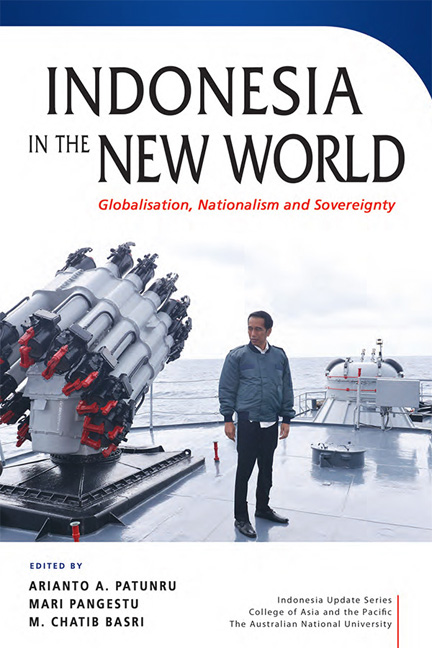Book contents
- Frontmatter
- Contents
- Tables
- Figures
- Contributor
- Acknowledgments
- Glossary
- 1 Challenges for Indonesia in the new world
- PART 1 Globalisation, Nationalism and Sovereignty: the Indonesian Experience
- 2 Challenging geography: asserting economic sovereignty in a porous archipelago
- 3 The new nationalism in Indonesia
- 4 Nationalism, sovereignty and foreign policy: Indonesia and the disputes over the South China Sea
- PART 2 Nationalism in Practice
- PART 3 Impact of and Response to Globalisation
- PART 4 The Human Face of Globalisation
- PART 5 Navigating The New Globalisation
- Index
- INDONESIA UPDATE SERIES
4 - Nationalism, sovereignty and foreign policy: Indonesia and the disputes over the South China Sea
from PART 1 - Globalisation, Nationalism and Sovereignty: the Indonesian Experience
Published online by Cambridge University Press: 08 June 2019
- Frontmatter
- Contents
- Tables
- Figures
- Contributor
- Acknowledgments
- Glossary
- 1 Challenges for Indonesia in the new world
- PART 1 Globalisation, Nationalism and Sovereignty: the Indonesian Experience
- 2 Challenging geography: asserting economic sovereignty in a porous archipelago
- 3 The new nationalism in Indonesia
- 4 Nationalism, sovereignty and foreign policy: Indonesia and the disputes over the South China Sea
- PART 2 Nationalism in Practice
- PART 3 Impact of and Response to Globalisation
- PART 4 The Human Face of Globalisation
- PART 5 Navigating The New Globalisation
- Index
- INDONESIA UPDATE SERIES
Summary
Since independence in 1945, Indonesia has sought to play a role in regional affairs proportionate to its size and location, while at the same time avoid¬ing involvement in the rivalries among major powers. This has become known as the ‘independent and active’ foreign policy doctrine of Indonesia. Territorial integrity and national security are two of the most important facets of the country's foreign policy. As early as 1957, as part of its Archi¬pelagic Outlook (Wawasan Nusantara) policy, the Indonesian government issued a declaration stating that all the waters surrounding and between the islands in the territory came within Indonesia's sovereignty. Although the declaration met with almost universal international condemnation at the time, two and a half decades later, in one of the country's best-known diplomatic and legal successes, Indonesia succeeded in having the ‘archi¬pelagic principle’ incorporated into the 1982 United Nations Convention on the Law of the Sea. This effectively gave legal and political support to Indonesia's territory as consisting of the islands, the intervening seas and the wider economic zone around the edges, thus greatly expanding the jurisdictional boundaries of the country.
With the ascension of President Suharto in the late 1960s, Indonesian foreign policy shifted from the confrontational character of the Sukarno years to an emphasis on close bilateral and multilateral cooperation, espe¬cially with other countries in the region. Post-Suharto governments have continued to stress pragmatism and good neighbourly relations, although national sentiment does flare up occasionally, sparked by incidents in which Indonesia's national pride has been ‘offended’ (mostly by Malaysia and Australia). As Anwar (2014) points out, pragmatism continues to act as a brake in most of these cases, preventing them from escalating into more severe conflicts. In summary, for the past half-century Indonesia has pursued a foreign policy that is geared towards protecting the national interest through cooperation rather than confrontation, through economic development rather than political adventurism, and through independ¬ent and active policy-making rather than alliances. The big question is whether such an approach to foreign policy still serves Indonesia well in dealing with the current regional and global dynamics, in particular the multiple territorial disputes in the South China Sea.
- Type
- Chapter
- Information
- Indonesia in the New WorldGlobalisation, Nationalism and Sovereignty, pp. 52 - 70Publisher: ISEAS–Yusof Ishak InstitutePrint publication year: 2018

